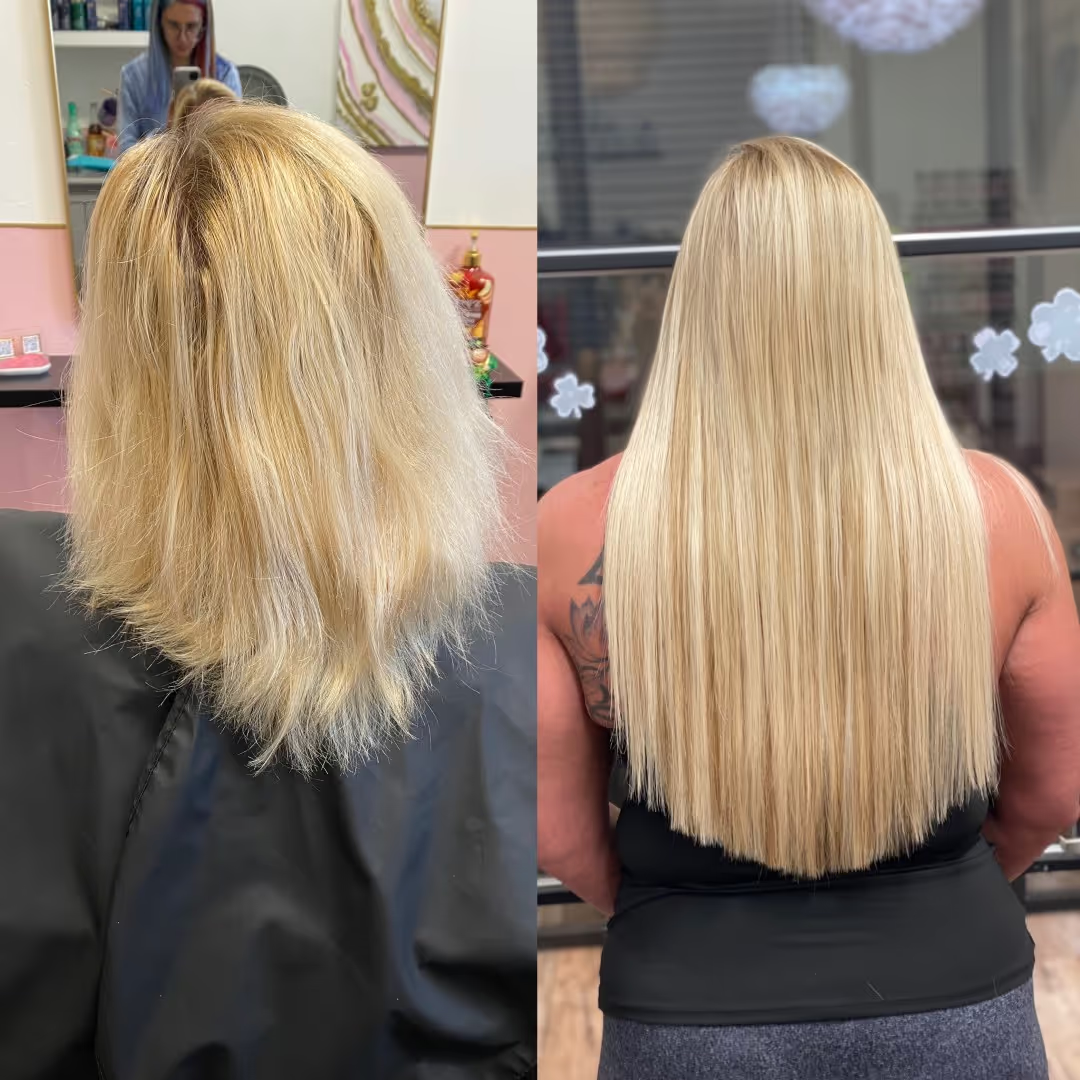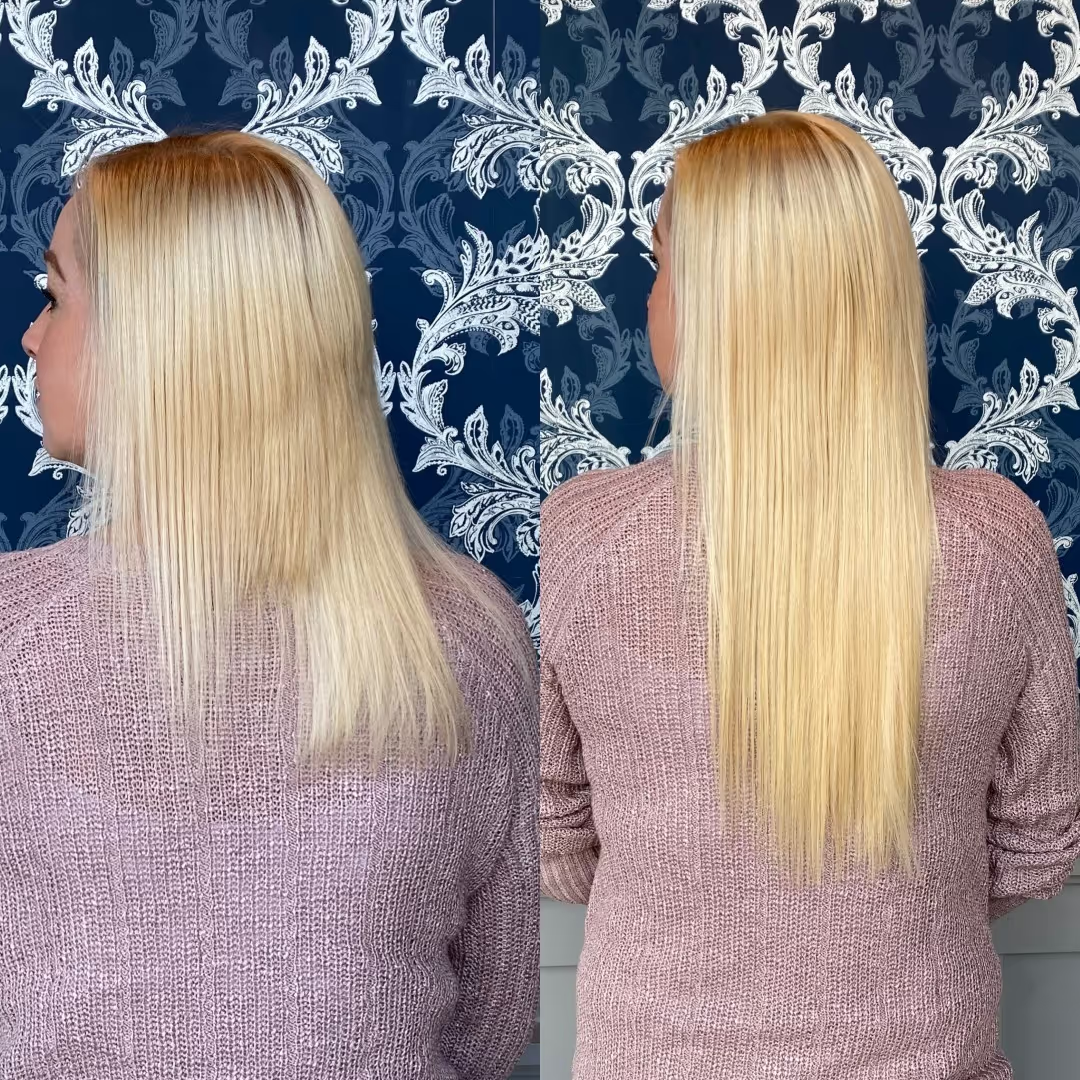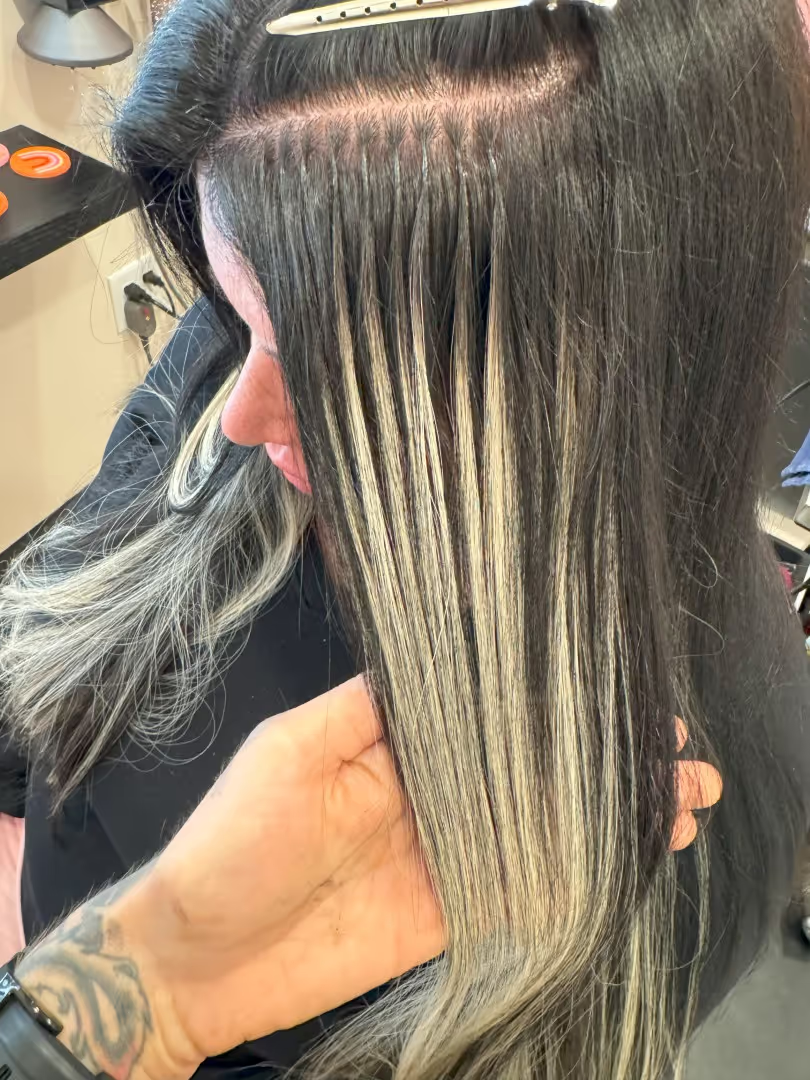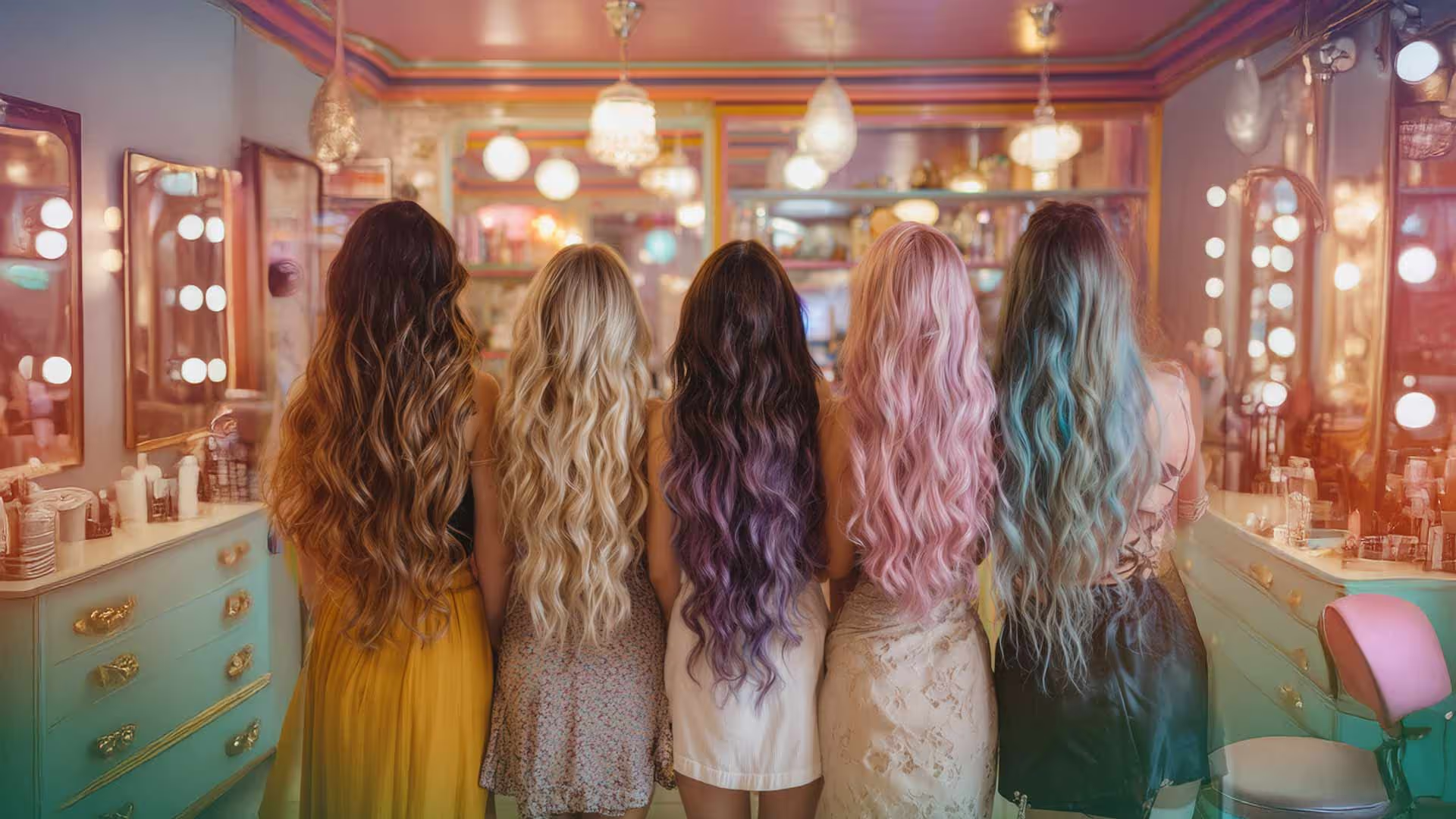Discover the best hair extensions for chemically damaged hair that allow natural movement, are reusable, and time-efficient. Expert recommendations for 2025.
Which hair extensions allow for natural movement, are a good choice for chemically damaged hair, can be reused, and are not overly time-consuming?
Tape-in extensions are generally the best choice for chemically damaged hair, offering natural movement, reusability, and relatively quick installation. They use medical-grade, waterproof adhesive that creates a "water-tight seal" with hypoallergenic properties, lying flat against the head with no tension for a realistic look.
Why Tape-In Extensions Excel for Damaged Hair:
- Natural Movement: Tape-in wefts lie flat on the head and blend seamlessly, providing excellent natural movement that moves naturally with your hair
- Safe for Chemically Damaged Hair: Medical-grade, waterproof adhesive distributes weight evenly across many strands, reducing strain on any single hair with no heat application
- Reusable: High-quality tape-ins can be removed with professional solvent sprays and repositioned 2-3 times with new adhesive
- Time-Efficient: Professional installation takes 30-45 minutes to 1-2 hours depending on volume, significantly faster than fusion (3-5 hours) or sew-in methods
- Versatile Styling: Can be styled just like natural hair for length, volume, or both
Other Excellent Options for Damaged Hair:
- Clip-in Extensions: Among the "least damaging options" available, 5-15 minute application, allow hair to recover between uses, ideal for fine or damaged hair
- Micro-link Extensions: Use tiny silicone-lined beads without heat or glue, "do not weigh hair or break it" when professionally applied, reusable and excellent for mild-moderate damage
- Halo Extensions: Cause "zero damage to your natural locks," less than 1-minute application, perfect for severely damaged hair
Key Takeaways
- Clip-in and halo extensions are the safest options for chemically damaged hair and time-efficiency
- Human hair extensions provide the most natural movement and styling versatility
- Proper application and removal techniques are crucial to prevent further damage
- Regular maintenance extends the life of extensions while protecting natural hair
- Some innovative methods like UV-cured extensions offer new options for damaged hair

Understanding Chemically Damaged Hair
Before diving into extension options, it's important to understand what happens when hair becomes chemically damaged and how this affects your extension choices.
Chemical treatments like bleaching, coloring, perming, and chemical straightening break down your hair's protein structure, leaving it porous, fragile, and more susceptible to damage. This damage not only affects appearance but fundamentally changes how your hair responds to styling and extensions.
"Chemical damage doesn't just affect the appearance of your hair—it fundamentally changes its structure," explains Jo DeBolt, certified extension specialist at Jo Hearts Hair in Lone Tree, Colorado. "When selecting extensions, we need to consider these structural changes to prevent further damage."
Signs of chemical damage include increased porosity, rough texture, lack of elasticity, excessive tangling, visible breakage, and dullness. The severity of these symptoms helps determine which extension methods are safest for your hair.

Top Extension Methods for Damaged Hair
Let's explore the best extension options that provide natural movement, reusability, and don't require excessive time commitment.
1. Tape-In Extensions: The Professional Solution
Tape-in extensions with medical-grade, waterproof adhesive stand out as the optimal balance between natural movement, durability, and hair health for those with chemical damage. These semi-permanent extensions create a "water-tight seal" with hypoallergenic adhesive and distribute weight evenly across horizontal sections rather than stressing individual strands.
Why They're Ideal for Damaged Hair
- Medical-grade, waterproof adhesive provides secure hold with no tension
- Creates a "water-tight seal" that lies flat for natural movement
- Even weight distribution minimizes stress on compromised hair
- No heat application during installation process
- Professional installation with experienced stylists takes 30-45 minutes to 1-2 hours
- Professional removal with solvent sprays ensures safe reapplication 2-3 times
"For clients with moderate chemical damage who want something more permanent than clip-ins, tape-ins are my go-to recommendation," says Jo. "The medical-grade adhesive and professional application make all the difference in preventing further damage."
The application process involves sectioning hair horizontally, applying the adhesive tape, and "sandwiching" natural hair between extension wefts. With chemically damaged hair, strategic placement away from the most compromised areas is crucial.
Maintenance requires avoiding conditioner at attachment points, gentle brushing to avoid tape bonds, and professional maintenance every 6-8 weeks.
2. Clip-In Extensions: The Versatile Solution
Clip-in extensions remain one of the "least damaging options" available for damaged hair, offering complete control over when and how you wear extensions. Industry sources agree that clip-ins are among the safest methods because they attach temporarily and require no glue, braiding, or excessive heat.
Why They're Perfect for Damaged Hair
- No permanent attachment means zero constant tension
- Daily removal gives your hair time to recover
- Customizable placement avoids severely damaged areas
- Natural movement with quality 100% Remy human hair
- Reusable for 6-12 months with proper care
- Application takes only 5-15 minutes
"I often start clients with damaged hair on clip-ins," says Jo. "They give instant gratification without compromising hair health, and I can teach them how to apply and remove properly to prevent any further damage."
The application process is straightforward: section your hair horizontally, lightly tease the roots for grip, snap the clips closed against the roots, and continue with additional wefts moving upward. With chemically damaged hair, using fewer wefts and ensuring they're not too heavy is crucial for preventing stress.
3. Halo Extensions: The Zero-Attachment Wonder
Halo extensions represent the gentlest option for severely damaged hair, with expert reviews confirming they "cause zero damage to your natural locks" and are "the only hair extensions that cause zero damage." These innovative extensions feature a transparent wire that sits around your head like a crown, with no direct attachment to your natural hair.
Perfect Protection for Fragile Hair
- Zero attachment to your hair strands
- No tension or pulling on damaged areas
- Application takes less than a minute
- Your natural hair remains completely untouched
- Exceptional comfort even with fragile hair
- Longer lifespan due to minimal handling
"For clients with severe chemical damage, halos are an absolute game-changer," Jo shares. "They give the appearance of thick, luscious hair without a single point of tension on the natural hair."
4. Micro-Link Extensions: The Heat-Free Alternative
Micro-link extensions (also called micro-bead or I-tip extensions) use tiny silicone-lined beads to attach individual strands to natural hair without heat, glue, or chemicals. This method offers excellent natural movement and reusability.
Benefits for Chemically Damaged Hair
- No heat application during installation
- Individual strand attachment allows for natural movement
- Beads can be moved up as hair grows
- Reusable for multiple applications
- Suitable for fine or thinning hair when applied properly
- Professional installation takes 2-3 hours

Comparative Analysis
To help you choose the best option, here's how different extension methods compare against our key criteria:

Extension Methods to Approach with Caution
Some methods present higher risks for chemically damaged hair and should be considered only in specific circumstances, if at all.
K-Tip/Fusion Extensions
K-tip extensions involve attaching individual strands to natural hair with keratin bonds, which can be problematic for damaged hair.
The concerns include:
- Heat application during installation
- Individual strand stress from the weight
- Special chemicals required for removal
- Extended application time (3-5 hours)
- Potential for heat damage near bonds
"I'm very selective about which clients with chemical damage I'll recommend K-tip extensions for," says Jo. "I assess their hair's condition thoroughly and sometimes suggest starting with a less permanent method first."
Sew-In Extensions
Sew-in methods require creating braids or tracks to sew the extensions onto, creating significant tension that damaged hair often can't tolerate. The tight braiding, limited scalp access, and extended wear period make this method generally unsuitable for chemically processed hair.
Human Hair vs. Synthetic: Making the Right Choice
The extension material significantly impacts natural movement, styling versatility, and longevity.
100% Remy Human Hair Extensions
For damaged hair, 100% Remy human hair extensions offer significant advantages:
- Natural movement that blends seamlessly with your own hair
- Heat styling compatibility for consistent styling with natural hair
- Can be professionally toned to match chemically processed hair
- Benefits from the same conditioning treatments as natural hair
- Typically lasts 6-12 months with proper care
The investment is higher ($150-800+ depending on type and quality), but for chemically damaged hair, the ability to treat, style, and blend makes human hair worth the cost.
Synthetic Hair Extensions
While more affordable ($75-150 for a full set), synthetic extensions present challenges for damaged hair:
- Limited heat styling options
- Less natural movement
- Difficult to blend with damaged hair that has texture inconsistencies
- Shorter lifespan (2-3 months maximum)
- Cannot be chemically treated to match damaged hair
"For clients with chemically damaged hair, I almost always recommend 100% Remy human hair extensions," says Jo. "The natural movement and styling versatility are crucial for creating a seamless blend with damaged hair that often has inconsistent texture."

Essential Care for Extensions with Damaged Hair
Proper maintenance is crucial for both extension longevity and natural hair health.
Daily Care Essentials
- Use an extension-specific brush
- Brush 2-3 times daily, starting at the ends and working up
- Support extensions at the attachment point while brushing
- Remove temporary extensions before sleeping
- Use silk or satin pillowcases to minimize friction
- Keep heat styling under 350°F and always use heat protectant
Washing Guidelines
For removable extensions:
- Wash every 15-20 wears with sulfate-free products
- Apply conditioner from mid-lengths to ends only
- Air dry flat on a towel, never hang when wet
For semi-permanent extensions:
- Keep conditioner away from attachment points
- Wash with head tilted back, never upside down
- Blow dry attachments completely to prevent mold
- Use extension-safe, sulfate-free formulas

Supporting Hair Recovery While Wearing Extensions
Using extensions doesn't mean neglecting your natural hair's recovery process.
For clip-ins and halos, deep condition your natural hair on days without extensions. With semi-permanent methods, schedule professional treatments between applications.
"I recommend alternating between protein and moisture treatments to restore chemically damaged hair," says Jo. "The extension break days are perfect for intensive repair sessions."
Consider establishing an extension wear schedule based on your damage level:
- For severely damaged hair: Wear clip-ins/halos maximum 3-4 days per week
- For moderate damage: Schedule 1-2 extension-free days per week
- For mild damage: Monitor hair condition and adjust accordingly
Professional vs. DIY Installation
The installation method can significantly impact how extensions affect damaged hair.
Professional Installation Benefits
- Expert assessment of hair's capacity to hold extensions
- Strategic positioning to minimize stress
- Proper spacing and tension control
- Professional color matching and blending
- Personalized care instructions
All semi-permanent methods (tape-ins, K-tip/fusion, sew-ins, micro-links) require professional installation by a certified stylist to minimize damage risk.
DIY-Friendly Options
- Clip-in extensions after proper education
- Halo/wire extensions (easiest for self-application)
"While clip-ins and halos can be applied at home, I always recommend at least one professional session to learn proper technique," advises Jo. "This is especially important for those with chemically damaged hair, which requires extra gentle handling."
Frequently Asked Questions
Can I get extensions if my hair is severely damaged from bleaching?
Yes. Halo extensions or carefully placed clip-ins are your safest options. Avoid any high-tension methods. A professional consultation is essential to determine if your hair can support extensions without causing further damage.
How long should I wait after a chemical treatment before getting extensions?
Wait at least 2 weeks after any chemical service before considering extensions. For more intensive treatments like bleaching or perms, 3-4 weeks is recommended. Signs you're ready include reduced shedding and improved elasticity.
Can I color my extensions to match my chemically treated hair?
100% Remy human hair extensions can be professionally colored, but only darker, never lighter. Extensions are already processed during manufacturing, so additional chemical treatment should be minimal. Your best approach is to buy extensions close to your desired shade and have a professional make minor adjustments.
What's the most time-efficient extension method for damaged hair?
Halo extensions are the fastest option, taking less than a minute to apply. Clip-ins require 5-15 minutes depending on how many wefts you use. Both allow for quick style changes and are suitable for chemically damaged hair.
How much do extensions for damaged hair typically cost?
- Clip-ins: $150-450 for quality human hair
- Halo extensions: $350-650
- Tape-ins: $450-850 (including professional installation)
- Micro-links: $500-900 (including professional installation)

Conclusion: Beautiful Hair Without the Damage
Tape-in extensions with medical-grade adhesive, professionally applied, offer the ideal combination of natural movement, reusability, and time-efficiency for chemically damaged hair. For those seeking even gentler alternatives, clip-in and halo extensions provide excellent options with zero permanent attachment.
The key to success lies in selecting the right extension method for your specific damage type, working with a knowledgeable professional stylist, and following a diligent care routine that supports both your extensions and natural hair health.
Remember that extensions should be part of your overall hair recovery strategy. With the right approach, they can be a confidence-boosting tool during your journey back to hair health.
Ready for Your Perfect Extensions?
Want personalized extension advice for your chemically damaged hair? Stop by Jo Hearts Hair in Lone Tree, and let's create your perfect hair solution together!
Located at: 9227 East Lincoln Ave, Suite #111, Lone Tree, CO 80124
Follow @joheartshair for daily inspiration and behind-the-scenes peeks at stunning transformations! ✨
Here's to beautiful, healthy hair,
XOXO,
Jo 💕




